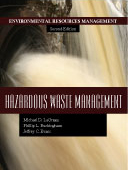Part I: FUNDAMENTALS
1. Hazardous Waste
Working Definition / Historical Roots / Landmark Episodes / Regulatory Initiatives / Classification / Generation / Contaminated Sites / Future Endeavors / Toward an Environmental Ethic
2. The Legal Framework
Environmental Law / Resource Conservation and Recovery Act / Federal Hazardous Waste Regulations under RCRA / Superfund / Other Federal Statutes / International Perspectives
3. Process Fundamentals
A Little Chemistry / Physical-Chemical Properties / Energy and Mass Balances / Reactions and Reactors / Geochemical Modeling and Analysis Programs
4. Fate and Transport of Contaminants
Contaminant Release / Transport of Contaminants in the Subsurface / Fate of Contaminants in the Subsurface / Atmospheric Transport and Dispersion of Contaminants
5. Toxicology
Exposure / Toxic Effects / Dose-Response Relationships / Noncarcinogens / Carcinogens / Ecotoxicology
Part II: CURRENT MANAGEMENT PRACTICES
6. Environmental Audits
Introduction / Program Planning / Preaudit Preparation / On-Site Audit / Evaluation and Presentation / Other Types of Audits
7. Pollution Prevention
General Considerations / Management Strategies / Life Cycle Analysis / Volume Reduction / Toxicity Reduction / Recycling
8. Facility Development and Operations
Facility Types / Facility Operations / Needs Assessment / Site Selection / Public Participation / Permitting
Part III: TREATMENT AND DISPOSAL METHODS
9. Physicochemical Processes
Air Stripping / Carbon Adsorption / Steam Stripping / Chemical Oxidation / Supercritical Fluids / Membrane Processes
10. Biological Methods
Basics of Microbial Metabolism / Biodegradation of Xenobiotics / Growth Kinetics / Ex Situ Systems—Treatment of Liquids / Ex Situ Systems—Slurry-Phase Treatment / Ex Situ Systems—Solid-Phase and Vapor-Phase Treatment / In Situ Biological Treatment Systems—Monitored Natural Attenuation / In Situ Biological Treatment Systems—Enhanced Degradation / Major Classes of Xenobiotic Compounds Amenable to Biological Treatment / Biological Treatment—Treatability Studies and Other Considerations
11. Stabilization and Solidification
Introduction / Mechanisms / Technology / Testing / Field Implementation / Design / Case Studies
12. Thermal Methods
Introduction / Regulations / Combustion / Gases and Vapors / Liquid Injection Incinerators / Solid Waste Incineration / Storage and Feed Systems / Flue Gas Temperature Reduction / Air Pollution Control / Instrumentation / Continuous Emission Monitors / Trial Burns / Mobile Systems
13. Land Disposal
Introduction / Landfill Operations / Site Selection / Liner and Leachate Collection Systems / Cover Systems / Materials / Contaminant Transport through Landfill Barriers / Landfill Stability / Surface Impoundments and Deep Well Injection / Closure and Postclosure Care
Part IV: SITE REMEDIATION
14. Quantitative Risk Assessment
Risk / Hazard Identification / Exposure Assessment / Toxicity Assessment / Risk Characterization / Risk Communication / Ecological Risk Assessment / Monte Carlo Methods / Case Study
15. Site and Subsurface Characterization
Introduction / Methodology / Planning / Methods of Site Characterization / Geophysical Methods / Boring and Sampling / Monitoring Wells / Geographic Information System / Case Study
16. Remedial Technologies
Introduction / Remedial Objectives / Passive Contaminant Control Systems / Surface Water Control Technologies / Groundwater Control: Vertical Barriers / Groundwater Control: Horizontal Barriers / Active Remediation Systems / Soil Vapor Extraction / Permeable Reactive Treatment Walls / Other Remedial Technologies
17. Evaluation and Selection of Remedial Actions and Corrective Measures
Overview or Remedy Selection Process / Case Study I—Evaluation and Selection of a Remedial Action for a "Model" Superfund Site / Site Conceptual Model / Remediation Objectives / Development of Alternatives / Analysis of Alternatives / Regulatory Guidance / Case Study 2—Focused Evaluation and Selection of an Interim Corrective Measure at an Operating Chemical Plant
Appendix A: Basel Convention
Appendix B: Contaminant Properties
Appendix C: Thermodynamic Properties
Appendix D: Conversion Factors

1202 pages, $178.95 list
1-57766-693-3
978-1-57766-693-6
© 2001
hardcover
eBook availability
Hazardous Waste Management
Second Edition
Hazardous waste management is a complex, interdisciplinary field that continues to grow and change as global conditions change. Mastering this evolving and multifaceted field of study requires knowledge of the sources and generation of hazardous wastes, the scientific and engineering principles necessary to eliminate the threats they pose to people and the environment, the laws regulating their disposal, and the best or most cost-effective methods for dealing with them.
Written for students with some background in engineering, this comprehensive, highly acclaimed text does not only provide detailed instructions on how to solve hazardous waste problems but also guides students to think about ways to approach these problems. Each richly detailed, self-contained chapter ends with a set of discussion topics and problems. Case studies, with equations and design examples, are provided throughout the book to give students the chance to evaluate the effectiveness of different treatment and containment technologies.
Written for students with some background in engineering, this comprehensive, highly acclaimed text does not only provide detailed instructions on how to solve hazardous waste problems but also guides students to think about ways to approach these problems. Each richly detailed, self-contained chapter ends with a set of discussion topics and problems. Case studies, with equations and design examples, are provided throughout the book to give students the chance to evaluate the effectiveness of different treatment and containment technologies.